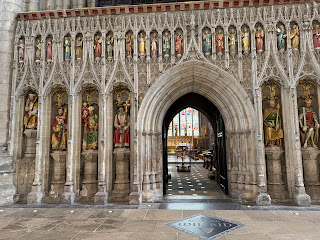We were driving past Ripon racecourse when I saw it, The Blackamoor Inn. We both did a doubletake, like all of us sensitised to the latest taboo. It’s hard to believe that such a sign would last long in some parts of Britain, when even ‘The Saracen’s Head’ is deemed controversial.
By coincidence, it seemed, we saw The Blackamoor again, this time in Ripon Cathedral. What was going on? I remembered the stick Princess Michael got for wearing Blackamoor jewellery once terribly fashionable and still commanding high prices in many parts of Europe.
I asked a very nice lady in Ripon Cathedral that same question. ‘What’s going on?’ And like everything in history, things are not black and white. The Blackamoor held pride of place in an C18th stained glass window and was apparently part of the cathredal’s coat of arms, not out of frivolity or exoticism but because he—a family servant—had dived into a swollen river and rescued the son and heir of the local landed family.
The lady confessed that at the height of the Black Lives Matter movement, cathedral authorities had been extremely worried. Might this too be a target? Let’s face it, cathedral windows have long been a target for iconoclasts.
Another stained glass window portrayed the man who founded Ripon Cathedral: Saint Wilfred. One wonders what he would think of such things.
The name Wilfrid is an old English word meaning one who ‘Desires Peace,’ or ‘Peaceful Ruler’. (Wil or desire and Frid or peace.) Wilfrid in fact was far from peaceful, causing dissent wherever he went. It’s debatable as to whether he was a saint but probably gained the honour, much like a dodgy OBE because he championed Rome and the Roman way of doing things against the indigenous Celtic Church.
Whatever the case, he founded Ripon Cathedral in 672 A.D, in the form of a small Roman basilica. The original crypt still stands, the oldest in Britain. The cathedral was rebuilt, in largely its present form, during the C12th. A tower was rebuilt after an earthquake in 1450 and extra naves added in the early C16th.
Sir Thomas Markenfield born c.1340 d.1398, fought in the Hundred Years War. His effigy lies here in the Markenfield chantry chapel on east side of the north transept.









No comments:
Post a Comment